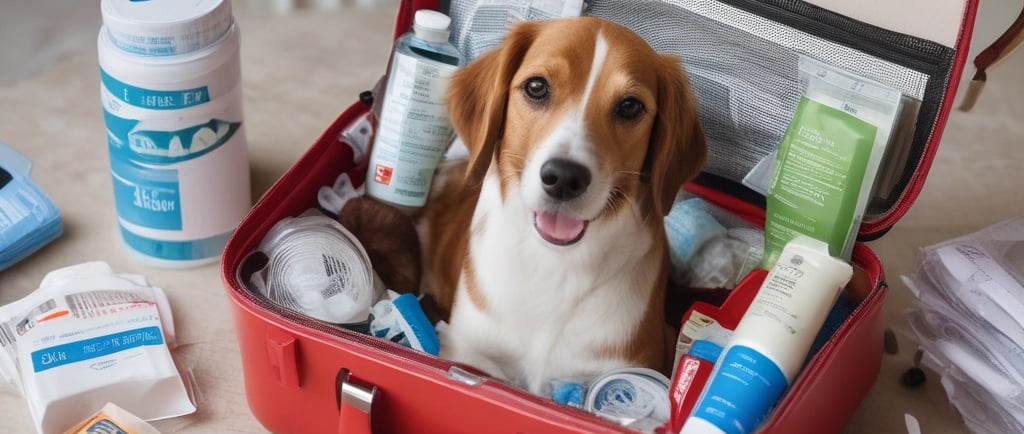🐾 Paws Prepared: How to Build a DIY Dog First Aid Kit 🚑
Every dog owner should have a first aid kit for emergencies. Here’s what to include: 🔹 Medical Basics: Gauze, self-adhering bandages, antiseptic wipes, blunt scissors, tick remover, styptic powder, saline solution. 🔹 Medications & Tools: Pet-safe antibiotic ointment, Benadryl (vet-dosed), hydrogen peroxide (for vet-directed use only), gloves, muzzle, thermometer. 🔹 Documents & Extras: Vet/poison control numbers, vaccination records, photo of your dog, treats, spare leash, blanket. ✨ Pro Tip: Check expiry dates every 6 months and always consult a vet after providing first aid. Be prepared—it could save your dog’s life! #DogFirstAid #PetSafety #KeirasDoghouse
9/16/20252 min read


At Keira's Doghouse, we believe in being prepared for everything—from matching outfits to unexpected bumps and scrapes. Just like you’d have a first aid kit for your human family, having one for your furry best friend is a non-negotiable part of responsible pet ownership.
Whether you’re hiking a rugged trail, playing at the dog park, or just relaxing at home, accidents can happen. A well-stocked dog first aid kit can help you stabilize your pup and provide crucial care before you can get to a vet.
Here’s your essential checklist to build a complete DIY Dog First Aid Kit at home!
📦 The Container:
Start with a durable, waterproof, and portable container. A tackle box, a sturdy plastic bin with a handle, or even a dedicated backpack works perfectly. Label it clearly: DOG FIRST AID.
⚕️ Essential Medical Supplies:
Gauze Pads & Roll: For cleaning wounds and controlling bleeding.
Self-Adhering Vet Wrap (e.g., Coban): This sticks to itself but not to fur—perfect for securing bandages without tape.
Non-Stick Sterile Pads: To cover wounds before wrapping.
Blunt-Tipped Scissors: For cutting bandages, tape, or matted fur.
Tick Remover Tool: Safer and more effective than tweezers for removing ticks whole.
Styptic Powder or Pencil: Stops minor bleeding quickly (great for accidentally trimmed nails!).
Saline Solution: For flushing out dirt from wounds or rinsing eyes.
Digital Thermometer: Know your dog’s normal temp (canine normal is 101–102.5°F).
Disposable Gloves: Keep things clean when handling wounds.
Tweezers: For removing splinters or debris.
🧴 Topical Treatments & Medications:
Antiseptic Wipes or Solution: (e.g., chlorhexidine or povidone-iodine diluted as directed) for cleaning wounds.
Antibiotic Ointment: Helps prevent infection in minor cuts (ensure it’s pet-safe; avoid ones with pain relievers).
Hydrogen Peroxide (3%): To induce vomiting ONLY if directed by a vet or poison control hotline.
Benadryl (Diphenhydramine): For allergic reactions (always know the correct dosage for your dog’s weight—ask your vet!).
Pet-Safe Pain Relief: Never give human meds like ibuprofen or acetaminophen. Only use pain meds prescribed by your vet.
📋 Important Documents & Tools:
Vet’s Phone Number & Address: Also include the number for the ASPCA Animal Poison Control Center (888-426-4435).
Photo of Your Dog: In case they get lost during an emergency.
Vaccination Records: Especially important if you need to board your dog unexpectedly.
Muzzle: Even the sweetest dog may bite when scared or in pain. A soft muzzle keeps everyone safe.
Flashlight or Headlamp: For checking eyes, ears, or wounds in low light.
🐶 Pup-Specific Comfort Items:
High-Value Treats: To keep your dog distracted and reward calm behavior.
Spare Leash & Collar: In case one breaks.
Blanket or Towel: Can be used for warmth, as a stretcher, or to clean up.
Cooling Pack: For reducing swelling or soothing hot paws.
✅ Pro Tips:
Check Expiry Dates: Go through your kit every 6 months to replace expired products.
Know How to Use It: A kit is useless if you don’t know how to apply a bandage or take a temperature. Consider taking a pet first aid course!
Make a Mini-Kit: Create a smaller version for your car or day pack.
Stay Calm: Your dog will feed off your energy. Take a deep breath and assess the situation calmly.
Remember: A first aid kit is for emergency and stabilization purposes only. It does not replace professional veterinary care. Always contact your vet after any incident.
We hope you never need it, but you’ll be so glad you have it if you do.
Does your dog have a first aid kit? Did we miss any of your must-have items? Share your tips on our Facebook page!
#DogFirstAid #PetSafety #DIYDogKit #KeirasDoghouse #DogMomLife #BePrepared
